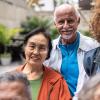
Janine Cataldo (left) and Glenna Dowling bring patients into the virtual world of electronic games (photos by Elisabeth Fall).
Can Virtual Health Care Environments Yield Real-World Health Improvements?
Editor’s Note: Over the next few months, Science of Caring will highlight two researchers a month whose work explores ways to improve health through the use of technology.
On the surface, Parkinson’s disease and lung cancer have little in common, except that both have a devastating effect on many people’s lives.
But two researchers from the UCSF School of Nursing Department of Physiological Nursing have discovered another link: the potential to use virtual electronic environments to help some patients manage these illnesses better than they can with existing methods.
Realizing that potential depends on pairing clinically valid interventions with complex technology – and then rigorously examining the results.
Walking Through a Virtual Lung Cancer Clinic
“Lung cancer is the leading cause of cancer death in both men and women,” says UCSF nurse scientist and researcher Janine Cataldo. Part of the reason is that lung cancer patients too often delay diagnosis. African American patients are particularly vulnerable to this syndrome; in addition, studies show that African Americans wait longer after diagnosis to receive or refuse treatment and are more likely to die in the hospital after surgery.
Cataldo’s work connects these facts with two contributing factors: the extremely high levels of psychological distress these patients face and poor communication with their doctors. “The communication problem is in part due to the stigma patients feel because lung cancer is associated with smoking, regardless of whether patients have ever smoked,” says Cataldo. “In our previous work we have found that lung cancer stigma is strongly associated with anxiety, depression, poor quality of life and an increased symptom burden for all lung cancer patients.”
She believes virtual environments show promise for combatting lung cancer stigma, and now has $250,000 in funding from California’s Tobacco-Related Disease Research Program to test her belief. Her project is called mHealth Tool for Lung Cancer Patients, or mHealth TLC.
Using a tablet device, Cataldo’s randomized controlled trial will walk 50 lung cancer patients through a 3-D virtual clinic before meeting with their actual clinician. Based on extensive patient interviews, Cataldo and her team developed real scenarios for the virtual experience. Patients interact with avatars that represent a receptionist, medical assistant and doctor. This enables them to practice communication skills so they can cope more effectively with lung cancer stigma. At the end of the “game,” they emerge with a printout that contains all the information they need, including the questions they want to ask their real doctor – and they receive feedback on how successful they were in getting what they needed.
The hope is not only that patients will understand better how to manage their illness, but also that they will experience reduced stress and symptoms, as well as improved quality of life. “We know from other studies that people can change behaviors using virtual environments, because there’s real immersion in a very safe environment,” says Cataldo.
The game also recognizes a reality of today’s health care: patients will have to assume more responsibility, a fact that’s especially urgent in the case of lung cancer. “They’ll have to navigate time pressures, as well as providers and front desk people with misinformation, bad moods and negative attitudes,” says Cataldo. “We hope that by allowing patients to practice and get feedback about what works, this intervention will help them speak up and get what they need to take care of themselves.” (Editor's Note: Cataldo's work was recently part of a story at the University of California's web site that examined the challenges of reaching underserved smokers before their lung cancer turns deadly.)
Dancing to the Rhythm of Parkinson’s Disease
Within the next 30 years, Parkinson’s disease will affect more than 20 million people in the United States. The poor balance, frequent falling and gait dysfunction that accompany the disease cause a deterioration in patients’ quality of life, including difficulties managing the activities of daily living.
Research has shown that physical activity can help ameliorate these symptoms, but not everyone has the resources or desire to join a gym or take a class. Besides, what happens when the class ends?
With that in mind, Glenna Dowling, chair of the UCSF Department of Physiological Nursing, has been progressively developing a Wii and Kinect-based game program that provides what she calls “a pragmatic home-based alternative to empower people with Parkinson’s disease to tailor their regimen around their daily lives.” When she and Marsha Melnick, a clinical professor in the UCSF School of Medicine’s Department of Physical Therapy and Rehabilitation Science, began developing games with developer Red Hill Studios, they were the first research team in the United States to receive National Institutes of Health (NIH) funding for development of a low-cost computerized physical therapy game.
Today, after two pilot studies that showed the games were safe and helped patients achieve small improvements in walking speed, balance and stride length, the partnership is taking its research to the next level. With additional funding from the NIH, the team will work with a larger patient group and build on the nine multilevel games they designed in the pilot studies by incorporating new research on the benefits of both tai chi and tango dancing for Parkinson’s patients. In addition, rather than requiring that patients wear an awkward suit, they will pair an infrared camera with a sophisticated sensor that includes a gyroscope, magnetometer and accelerometer so the researchers can better assess patient movement and rotation.
“Ultimately, we’re looking at function, which we need to measure in a number of ways,” says Dowling.
The program also will enable a live data feed via a web portal, so clinicians can track progress over time and tailor the interventions accordingly.
“Technology makes interventions and assessments available to a much broader scope of people,” says Dowling. “But it has to be paired with clinician expertise, so we can prescribe a specific regimen that targets the deficits each person has.”



